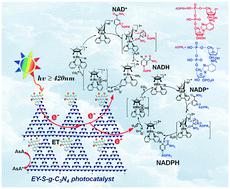当前位置:
X-MOL 学术
›
Catal. Sci. Technol.
›
论文详情
Our official English website, www.x-mol.net, welcomes your
feedback! (Note: you will need to create a separate account there.)
Eosin-Y and sulfur-codoped g-C3N4 composite for photocatalytic applications: the regeneration of NADH/NADPH and the oxidation of sulfide to sulfoxide
Catalysis Science & Technology ( IF 4.4 ) Pub Date : 2021-08-25 , DOI: 10.1039/d1cy00991e Pooja Singh 1 , Rajesh K. Yadav 1 , Krishna Kumar 1 , Yubin Lee 2 , Abhishek K. Gupta 3 , Kuldeep Kumar 4 , B. C. Yadav 4 , S. N. Singh 5 , D. K. Dwivedi 3 , Sang-Ho Nam 2, 6 , Atul P. Singh 7 , Tae Wu Kim 2, 6
Catalysis Science & Technology ( IF 4.4 ) Pub Date : 2021-08-25 , DOI: 10.1039/d1cy00991e Pooja Singh 1 , Rajesh K. Yadav 1 , Krishna Kumar 1 , Yubin Lee 2 , Abhishek K. Gupta 3 , Kuldeep Kumar 4 , B. C. Yadav 4 , S. N. Singh 5 , D. K. Dwivedi 3 , Sang-Ho Nam 2, 6 , Atul P. Singh 7 , Tae Wu Kim 2, 6
Affiliation

|
Graphitic carbon nitride (g-C3N4) is a promising two-dimensional semiconducting material that has shown potential for various applications in the field of photocatalysts due to its thermal stability and excellent electronic properties. However, pristine g-C3N4 has a wide optical band gap, which limits the active absorption of solar light in the spectral region below 420 nm. One way to improve the optical character is by doping with a sulfur heteroatom to make sulfur-doped g-C3N4 (S-g-C3N4), which has a smaller band gap relative to the pristine g-C3N4. Herein, we have developed a new type of S-g-C3N4 composite incorporating eosin-Y (EY–S-g-C3N4) by employing the co-polymerization approach between eosin-Y (EY) and S-g-C3N4. In this composite, eosin-Y moieties act as external photosensitizing groups. The optical characteristics of EY–S-g-C3N4 were investigated using density functional theory, various optical spectroscopies, and various imaging techniques. From those characterizations, it was found that the appearance of the charge-transfer state in the low band gap regime improved the light-harvesting ability relative to the g-C3N4 and S-g-C3N4. The use of the EY–S-g-C3N4 photocatalyst for the regeneration of NADH and NADPH showed quite excellent efficiencies of 64.38% and 81.14%, respectively. In addition, it showed the high conversion efficiency of sulfide to sulfoxide with an yield of 99.6%. This research highlights the potential application of the EY–S-g-C3N4 composite in the field of organic transformation based on photoinduced conversion.
中文翻译:

用于光催化应用的曙红-Y 和硫共掺杂 g-C3N4 复合材料:NADH/NADPH 的再生和硫化物氧化成亚砜
石墨氮化碳(gC 3 N 4)是一种很有前途的二维半导体材料,由于其热稳定性和优异的电子性能,在光催化剂领域显示出各种应用的潜力。然而,原始的 gC 3 N 4具有很宽的光学带隙,这限制了太阳光在低于 420 nm 的光谱区域内的主动吸收。改善光学特性的一种方法是通过掺杂硫杂原子来制造硫掺杂的 gC 3 N 4 (SgC 3 N 4 ),其相对于原始 gC 3 N 4具有更小的带隙. 在此,我们通过采用曙红-Y (EY) 和 SgC 3 N 4之间的共聚方法开发了一种新型的 SgC 3 N 4复合材料,其中包含曙红-Y (EY–SgC 3 N 4 ) 。在该复合材料中,曙红-Y 部分充当外部光敏基团。使用密度泛函理论、各种光谱学和各种成像技术研究了 EY-SgC 3 N 4的光学特性。从这些表征中发现,相对于 gC 3 N 4而言,低带隙区域中电荷转移状态的出现提高了光捕获能力和 SgC 3 N 4。使用 EY-SgC 3 N 4光催化剂再生 NADH 和 NADPH 分别显示出非常出色的效率,分别为 64.38% 和 81.14%。此外,它显示出硫化物到亚砜的高转化率,产率为 99.6%。该研究突出了 EY-SgC 3 N 4复合材料在基于光致转化的有机转化领域的潜在应用。
更新日期:2021-09-10
中文翻译:

用于光催化应用的曙红-Y 和硫共掺杂 g-C3N4 复合材料:NADH/NADPH 的再生和硫化物氧化成亚砜
石墨氮化碳(gC 3 N 4)是一种很有前途的二维半导体材料,由于其热稳定性和优异的电子性能,在光催化剂领域显示出各种应用的潜力。然而,原始的 gC 3 N 4具有很宽的光学带隙,这限制了太阳光在低于 420 nm 的光谱区域内的主动吸收。改善光学特性的一种方法是通过掺杂硫杂原子来制造硫掺杂的 gC 3 N 4 (SgC 3 N 4 ),其相对于原始 gC 3 N 4具有更小的带隙. 在此,我们通过采用曙红-Y (EY) 和 SgC 3 N 4之间的共聚方法开发了一种新型的 SgC 3 N 4复合材料,其中包含曙红-Y (EY–SgC 3 N 4 ) 。在该复合材料中,曙红-Y 部分充当外部光敏基团。使用密度泛函理论、各种光谱学和各种成像技术研究了 EY-SgC 3 N 4的光学特性。从这些表征中发现,相对于 gC 3 N 4而言,低带隙区域中电荷转移状态的出现提高了光捕获能力和 SgC 3 N 4。使用 EY-SgC 3 N 4光催化剂再生 NADH 和 NADPH 分别显示出非常出色的效率,分别为 64.38% 和 81.14%。此外,它显示出硫化物到亚砜的高转化率,产率为 99.6%。该研究突出了 EY-SgC 3 N 4复合材料在基于光致转化的有机转化领域的潜在应用。











































 京公网安备 11010802027423号
京公网安备 11010802027423号